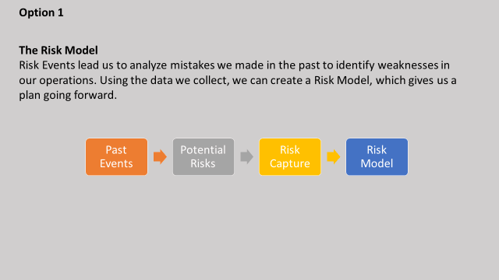Blog
ID Essentials: Four Simple Steps to Unpack Objectives
By Ann Iverson, Instructional Designer You’ve been asked to design an e-learning course on the topic of risk management. You want to include an ...


5 Ways to Tap into Metaphors for Better E-learning Courses
By Ann Iverson | June 23, 2015 | Custom Learning | 0 Comments
By Ann Iverson, Instructional Designer
.png?width=125&name=Ann(250).png)
You’ve been asked to design an e-learning course on the topic of risk management. You want to include an introduction that sets the stage for the e-learning course and helps learners know quickly what they’re about to dive into. You begin typing…
Risk management is the systematic process of understanding, evaluating, and addressing the risks that maximize the chances of objectives being achieved and ensuring organizations, individuals, and communities are sustainable.
You stop in your tracks and scream like a crazy person,
“No, I refuse to waste my brilliance and my learners’ time like this!” You vow to make a change, starting now. You turn to your usual tool in times of confusion like this, and consult your Magic 8 Ball. You ask the ultimate oracle, “How can I create a better e-learning course introduction?” You shake the orb with all of your might and view the response, “Concentrate and ask again.” Your shoulders droop in despair.
But wait! There’s other magic you can access without the inscrutable responses and all that shaking. What about the magic of metaphors? This figure of speech helps simplify complex and abstract concepts in a meaningful and relatable way. Eureka! You may have just discovered the secret of success!
What is a metaphor?
Metaphors can simplify a topic and improve understanding. They tap what learning theorists call ‘prior knowledge’ to make a connection between what people already understand through experience and what they have yet to discover. They compare the unfamiliar with the familiar. Most people have used or seen a dashboard in a car. Dashboards organize and simplify all the information the driver needs to navigate safely and successfully on the road. For example, rather than the distraction of calculating distance divided by time, the driver can simply view the speedometer to ensure he or she is maintaining an accurate speed. In the words of Andrew Tarvin, humor engineer,
“Einstein was a genius not because he theorized about things like mass-energy equivalence (others had done it before him), but because he could distill it down to E = mc².”
Why use metaphors?
Metaphors aren’t just linguistic tricks that make people smile. Although well-chosen metaphors can be very entertaining, they actually guide behavior. Cognitive scientists agree that metaphors have the power to transform the way people think and how they respond. They allow learners to comprehend new and complicated information more quickly and easily. For example, which option do you think is more memorable and easier to understand from the start?


It’s easy to see the magic of metaphors in this very simple example—to simplify new concepts by connecting them to an object the learners already know. Also, using metaphors can help instructional designers avoid the dreaded info-dump by weeding out overly-complicated terms and information. Using a good metaphor requires prioritization and balance to determine what content is essential for learners to understand right away.
How to use metaphors?
When you identify a course topic that is clearly complex, usually more technical or mechanical, consider using a metaphor to drive the concept home in the organization. Here are five ways to tap into the magic of metaphors:
1. Look for existing metaphors
Pay attention to metaphors that surface during client conversations. You’ll want to avoid any worn-out language, as it has become uninspiring and forgettable, and focus on new concepts that arise. For example, during a recent design meeting, our stakeholders compared employees to ninjas who are disciplined and flexible in their practice. After careful consideration and client agreement, we used ninja traits and images in the design to explain the type of characteristics needed to manage change in the organization.
2. Customize metaphors to the culture
When it comes to metaphors, one size doesn’t fit all. Consider which metaphor is appropriate for your particular learning audience. For example, sports metaphors may have a strong impact in some organizations, but not in others. Metaphors can carry a cultural meaning that may not be a good fit outside the culture. Select the metaphor that best highlights the concept you want to reinforce and is the best fit for the learning audience.
3. Ask subject matter experts for help
You don’t have to do this alone! Subject Matter Experts (SMEs) often battle with how to explain complex ideas in simpler terms. Asking them for ideas provides you with useful information to discover options for when and how to use a metaphor. You may want to brainstorm ideas by asking questions to trigger metaphors such as:
- If you had to describe your process with a song title, what would you choose?
- What common household item does this complicated piece of machinery bring to mind?
- How is your customer service model like a salad bar? Thunderstorm? Racetrack?
You want to ask questions that help uncover the associations that would help learners visualize and understand the concepts.
We brainstormed metaphors for financial calculations during a recent session resulting in these ideas:
- They’re like a puzzle, and satisfaction comes from figuring them out
- They’re like a journey, like taking a road trip to get to a very inviting destination
- They’re like a tool, helping you complete certain processes
4. Come up with a few ideas on your own
Sometimes it’s easier to toss out a few ideas, and then partner with stakeholders to build on them. Let’s say you’re designing an e-learning course on change management, and you’d like to kick it off with a metaphor emphasizing that without change, the organization will not progress. Think about the characteristics for something that doesn’t change: It can get pushed aside, it stagnates, it can’t go forward, it stays behind while others are moving past it, etc. Now consider imagery for these words. For example, the word “stagnate” might bring to mind a pond that accumulates debris because the water can’t flow freely. So the metaphor becomes: A lack of change in an organization is like a pond, cluttered with the waste of outdated systems and practices that prevent the flow of fresh ideas.
5. Avoid overusing or forcing the metaphor
You’ll most likely want to position the metaphor at the course introduction to engage learners right away and begin simplifying the topic. But, when is enough? Metaphors can quickly become stale from overuse, so you’ll want to integrate them carefully and seamlessly.
Using metaphors in e-learning is like taking an elevator. While you can certainly walk up the steps to the get to the 25th floor, getting a ride helps save time and energy. Good metaphors carry a high value in e-learning as they help learners integrate complex concepts into their real-life work situations and help instructional designers avoid info-dumping. Do you have a favorite metaphor you’ve used in a course? Please share!
WANT TO SHARE THIS BLOG? CLICK THIS READY-MADE TWEET BELOW!
CLICK TO TWEET! NEW #aiblog: 5 Ways to tap into #metaphors for better #e-learning courses http://hubs.ly/y0WyYr0 @customelearning
.png?width=135&height=135&name=Ann(250).png)
About the Author: Ann Iverson
Ann is an instructional designer for Allen Interactions who’s consulted for many years with a variety of clients, industries and projects. She learns best by making mistakes!
Comments
Would you like to leave a comment?
Related Blog Posts

By: Ann Iverson | Nov, 2016
Category: Custom Learning

Blog
ID Essentials: Three Steps When There’s Too Much Content for One Course
By Ann Iverson, Instructional Designer You’ve been asked to design an e-learning course on the topic of risk management. You want to include an ...
By: Ann Iverson | Dec, 2016
Category: Custom Learning

Blog
5 Ways Clients Can Foster Success in an e-Learning Project
By Ann Iverson, Instructional Designer You’ve been asked to design an e-learning course on the topic of risk management. You want to include an ...
By: Ann Iverson | Aug, 2015
Category: Custom Learning


